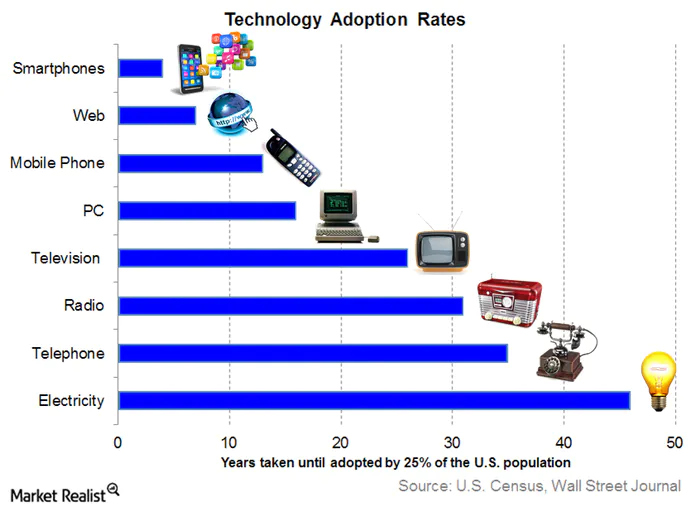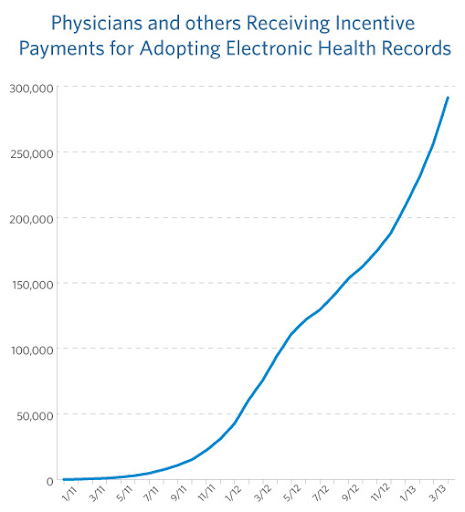We have entered a new decade; the 20’s. Just a few decades ago, people thought we would have flying cars, hoverboards and other futuristic technologies by now.
While those sort of predictions were mostly wrong, it’s worth questioning why some fundamental technological advances remain stagnant, unrefined or just simply have not been adopted.
This is especially true in healthcare, where patients still fill out paper forms that are then manually entered into a computer by the receptionist and too many people waste time sitting in waiting rooms because their appointments are still scheduled manually. Better communication, shorter lines, less hassle and saving money are all frustrations that can (and should) be addressed in the near term.
Technology like smartphones and the software that makes them one of the most important innovations in recent history were only invented a little over a decade ago but already 80%+ of Americans (over 18 years old) own a smartphone. Not to mention the fact that 96% of Americans own a voice- and text-enabled mobile phone (both “smart” and “dumb”).
The bottom line is that mobile phones are here to stay.

All of this context is important to understand as we begin to determine why the healthcare industry lags so far behind with their adoption of digital communication and how we can all work to solve that problem.
Understanding the Root Cause of Healthcare’s Lagging Technology
For decades, the healthcare industry has lagged behind in implementing new technologies that focus on anything other than their core competencies.
In a way, it’s great that all investment is focused on research, vaccines, medicine… healthcare. Unfortunately, that means little investment is being made into technology that makes operations more efficient, cheaper and simpler for those we serve: our patients.
As industry leaders, we may not think efficiency and ease matter that much, but today’s consumers expect 2-day shipping (on anything) and same-day grocery delivery. Those same consumers (your patients) will happily shop for a provider that makes their life easier.
But let’s be fair; healthcare is a complex industry with many different layers and “customers” driving the decisions. Any changes to a system or process requires consideration of how it will impact patients, insurance, and financials while also ensuring it remains compliant with the many governing regulations.
These 3 Factors Seem to Be the Main Drivers For a Lagging Industry:
- Complexity of Implementation and Support
- Governing Regulation
- Lack of Financial Incentives
1. Complexity of Implementation and Support
Modernizing any operation, in any industry, is not simple, and since most practices do not have the budget (or experience) to hire a team of software developers, they have to outsource it.
Anyone that has experience working with a team to implement a new system/machine/software will tell you that it is complicated and requires a concerted effort. What they will also tell you is that the support required after implementation is just as important.
Too often, organizations will commit to investing in a new solution without fully understanding the effort it takes to not only implement it, but also to manage it. For healthcare, that effort is multiplied by the regulatory requirements inherent in patient records and information.
“The digital health revolution is creating crucial regulatory, compliance, and legal challenges for the healthcare sector. Going digital means complying with complicated legislations like HIPAA – and extra work for the healthcare workers involved. This can discourage them from adopting technology, and they feel more satisfied with the current systems.” [source article].
At OM Performance Marketing Agency, our mission is to drive the digital transformation of healthcare. We recognize the difficulty of bringing that mission to fruition, especially how difficult it will be for healthcare organizations that typically do not have anyone who is an expert in digital communications. This is why we have developed a performance marketing program for results-driven organizations that starts with a core foundation and scales up to world-class digital marketing.
2. Governing Regulation
Some regulation of the healthcare industry is required as it is a vital service that affects every member of society. A service so fundamental to our wellbeing naturally requires some oversight, but it is important for us to realize that regulation adds complexity to the way our healthcare system operates. And yes, that includes how providers can communicate with their patients.
The excerpt below does a very good job of summarizing the dilemma:
“Several regulatory barriers may explain why physicians have lagged behind other industries in developing and using electronic communication platforms. For one, some physicians report a lack of financial incentive because they cannot bill for these technologies.” [source article].
Despite the feeling that our “hands are tied”, we should always be looking for ways to improve our current processes. It is not easy but without the effort we cannot effectively serve our patients and improve their well-being.
3. Lack of Financial Incentives
The final, and possibly most controllable root cause, is the lack of financial incentives for providers. Although many people become healthcare professionals to help others, they cannot eat if they’re not making money. Looking at it from the perspective of running an operation; a private practice cannot survive if they are not able to pay their bills.
Deeper than the challenge of running a profitable practice is the fundamental problem of how the healthcare industry is rewarded based on the wrong metrics: the cost and number of patients.
This is not the fault of individual providers, but rather the well-intentioned regulations enforced on the industry.
“Doctors and hospitals will be slow to embrace any technology that lowers costs or reduces patient visits. Why? Because today’s payment model financially rewards doctors and hospitals for the volume and cost of services they provide – not the quality of outcomes they achieve.” [source article].
This is a very frustrating position to be in but healthcare providers control their own budget and have the ability to do what is best for their patients and employees. Instead of focusing on the problems with regulations, focus on making progress and adding value. Opportunity is in every industry and adding value for clients/patients will always be a winning strategy.
A Possible Solution
Where do we go from here?
There is no one-size-fits-all solution to implementing a new process or tool, but many organizations have done it successfully. We should learn from both the successes and failures of other organizations. A good start is to speak with other leaders in your network and industry.
Start Small
When we want change and progress, we want to go all-in. “Go big or go home,” right?
We push hard and try to let the momentum carry us. That strategy can be effective but can also make things worse in the long run.
Many providers were quick to jump in and implement an Electronic Health Record (EHR) system after 2009 when the Obama administration provided financial incentives.

The problem with the rapid EHR adoption is that it was premature and resulted in an overwhelmingly burdensome system for the medical staff; in fact, the American Medical Association published a study in 2019 that surveyed nearly 900 doctors who on average graded their EHR with an “F” [source article].
A smaller, controlled and steady approach is more likely to be a winning strategy.
Identify problems, prioritize them, and research solutions to each problem. Keep in mind that every problem does not need to be solved at once – this is a process that takes time and will not happen overnight.
“In the meantime, it may be worth thinking about starting with small changes that have the potential to save providers time—if not by scheduling fewer appointments, then by simplifying “time-sucking” administrative tasks such as medical billing.” [source article].
Communicate Progress
Out of all the challenges we will face; internal pushback from our team is inevitable. Change is hard and we should not expect our teams to happily jump on the bandwagon without us first communicating the goal and expectations.
Remember the old adage “communication is key.” People deserve transparency.
Summary
The healthcare industry has struggled to modernize anything that is not directly related to their core competencies. This is good since most investments are focused on finding life-changing treatments but it neglects the demand for patient-centered solutions at every step.
As we move into a more socially-distanced world, it is important that we understand the driving forces that limit our ability to modernize and find solutions to implement and solve for the new digital form of patient demand.


